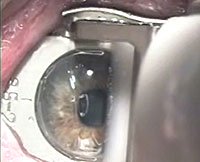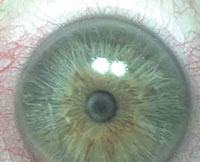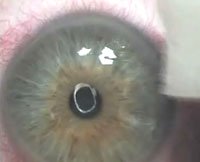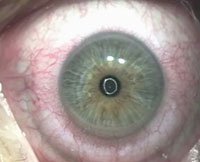Epi-LASIK has advantages over PRK, surgeons find
The clean flap created with epi-LASIK may be one of the key advantages of the procedure.
Epi-LASIK seems to provide advantages over PRK, including a faster healing time and less pain, according to surgeons experienced with both techniques.
The biggest advantage of epi-LASIK over PRK might be the perfectly round, smooth-edged epithelial flap created by the epikeratome, according to Kerry D. Solomon, MD, PhD. The flap is created without the manual scraping used in PRK, which can cause irregularities in Bowman’s membrane, Dr. Solomon said.
Y. Ralph Chu, MD, said the epikeratome-based procedure involves significantly less postoperative pain than PRK, making it potentially the preferred surface ablation procedure.
Epi-LASIK compared to PRK
Dr. Solomon is conducting a clinical study to compare the two surface procedures. Patients who have undergone epi-LASIK or PRK are being followed to assess their epithelial healing times, discomfort levels and visual recovery.
The study is evaluating both retaining the epithelial sheet after surgery and discarding it. To date, Dr. Solomon said, it seems that the best way to perform the technique may be to use the epikeratome to create the epi-LASIK flap but then to discard the flap and let the epithelium grow back.
“The advantage of epi-LASIK may actually be a quicker, cleaner removal of the epithelium as it compares to PRK,” he said.
Dr. Solomon said he does not prefer performing one technique over the other because they are essentially different forms of the same procedure. However, he said he would rather use epi-LASIK than laser epithelial keratomileusis (LASEK) because it avoids the alcohol used in that technique.
“The thought with epi-LASIK is, because it is mechanical separation, the epithelium may remain viable,” Dr. Solomon said. “That may be the case, and maybe pain is reduced and maybe visual recovery is assisted.”
Dr. Solomon said that for patients who come to his practice requesting PRK, he would suggest epi-LASIK instead to almost all of them, provided there was no potential problem with mounting the suction ring on the patient’s eye. Dr. Solomon uses the Epikeratome on the Advanced Medical Optics Amadeus II microkeratome for performing epi-LASIK.
|
|
|
|
|
Images: Chu YR |
Clinical experience
Dr. Chu, a refractive surgeon in Edina, U.S.A., said he began performing epi-LASIK with the epikeratome on the Amadeus II microkeratome this year, but he has been performing surface ablation procedures for many years. “Our results with surface ablation procedures like PRK and epi-LASIK have been great,” Dr. Chu said.
He said surgeons are always looking for a better way to perform surface ablation safely. He said his refractive surgery of choice in appropriate candidates is LASIK, while PRK and epi-LASIK are both viable “additives” to LASIK.
“We’re trying to treat those people who wouldn’t be great LASIK candidates in a more quick, efficient and comfortable way for the patient,” Dr. Chu said. “The drawbacks to PRK are the longer recovery time and more inconvenience and discomfort for the patient. That’s where I think epi-LASIK is an evolution over PRK. It also allows patients that may not be great LASIK candidates to have a safer alternative in terms of refractive surgery.”
Dr. Chu said he uses epi-LASIK or PRK when the patient’s characteristics warrant them, in cases with thin corneas, asymmetric topographies, anterior membrane dystrophy or dry eye. Of the surface-based procedures he considers epi-LASIK his procedure of choice, he said.
Treatment details
Dr. Solomon said his regimen for patients after epi-LASIK patients is the same as for PRK. He prescribes a mild steroid such as fluorometholone, an antibiotic, a preservative-free nonsteroidal anti-inflammatory drug four times a day and Zymar (gatifloxacin ophthalmic solution 0.3%, Allergan) four times a day for a week or until the epithelium is healed. A bandage contact lens is applied until the eye is healed, typically 3 to 4 days after the surgery. The antibiotic is then stopped but the steroid is continued four times a day for a month, followed by a quick taper. He said he is looking into possibly using preservative-free tetracaine in his study.
Dr. Chu’s postoperative regimen is similar to Dr. Solomon’s. He also prescribes an NSAID four times a day postoperatively until the surface has re-epithelialized. Dr. Chu also places a bandage contact lens. He said nonpreserved artificial tears are also important for lubrication. Zymar and a mild steroid are also used. As needed, patients also receive several tablets of an oral narcotic to help them sleep for the first few days after surgery, he said.
For Your Information:
- Kerry D. Solomon, MD, PhD, can be reached at the Storm Eye Institute, Medical University of South Carolina, 167 Ashley Ave., Room 221, P.O. Box 250676, Charleston, SC 29425 U.S.A.; +1-843-792-8854; fax: +1-843-792-6347; e-mail: solomonk@musc.edu.
- Y. Ralph Chu, MD, can be reached at Chu Vision Institute, 7760 France Ave. South, Suite 140, Edina, MN 55435 U.S.A.; +1-952-835-1092; +1-952-835-4768; e-mail: yrchu@chuvision.com; Web site: www.chuvision.com.
- Erin L. Boyle is an OSN Staff Writer who covers all aspects of ophthalmology.




